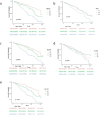Correlation between CBC-derived inflammatory indicators and all-cause mortality with rheumatoid arthritis: a population-based study
- PMID: 40557044
- PMCID: PMC12185416
- DOI: 10.3389/fmed.2025.1538710
Correlation between CBC-derived inflammatory indicators and all-cause mortality with rheumatoid arthritis: a population-based study
Abstract
Objectives: We investigated the relationship between inflammatory indicators derived from complete blood cell (CBC) counts and all-cause mortality in individuals with rheumatoid arthritis (RA).
Methods: Data were collected from the National Health and Nutrition Examination Survey (NHANES) database from 2007 to 2018, with a median follow-up duration of 78 months. The inflammatory indicators derived from CBC included several types: the systemic inflammatory response index (SIRI), the systemic immune-inflammation index (SII), the neutrophil-to-lymphocyte ratio (NLR), the platelet-to-lymphocyte ratio (PLR), and the monocyte-to-lymphocyte ratio (MLR). The multiple COX regression models were used to estimate adjusted hazard ratios (HRs) and 95% CIs concerning all-cause mortality of participants with RA, which focused on CBC-derived inflammatory indicators. Additionally, restricted cubic spline (RCS) curve was utilized to investigate non-linear associations.
Results: The research comprised a cohort of 1,314 individuals, among whom 246 with RA succumbed during a median follow-up duration of 78 months. After adjusting for key covariates, the mortality rate in patients with RA who had high SIRI, NLR, and MLR levels was considerably higher than in those with medium or low SIRI, NLR, and MLR levels. Compared with the lowest tertile, the highest tertiles of SIRI (HR 1.87, 95% CI: 1.12-3.13), NLR (HR 1.79, 95% CI: 1.10-2.92), and MLR (HR 1.88, 95% CI: 1.17-3.02) were associated with an increased risk of all-cause mortality. The Kaplan-Meier analysis indicated a significant decrease in the survival probability among individuals with elevated SIRI, NLR, and MLR levels. The RCS analysis revealed a linear association between SIRI, NLR, MLR, and RA-related all-cause mortality, whereas a non-linear relationship was identified between the SII, PLR, and mortality.
Conclusion: This investigation revealed that the SIRI, NLR, and MLR are novel, valuable, and convenient inflammatory indicators. In the United States adults with RA, higher SIRI, NLR, and MLR were independently associated with an increased long-term mortality risk. These findings not only assist in uncovering the potential utility of predicting RA outcomes but also provide rheumatologists valuable guidance for disease management.
Keywords: NHANES; monocyte-to-lymphocyte ratio; mortality; neutrophil-to-lymphocyte ratio; rheumatoid arthritis; systemic inflammatory response index.
Copyright © 2025 Liu, Liu, Fan, Yang, Xu, Zhao, Liu, Xing and Kong.
Conflict of interest statement
The authors declare that the research was conducted in the absence of any commercial or financial relationships that could be construed as a potential conflict of interest.
Figures




Similar articles
-
Impact of systemic immune inflammation index and systemic inflammation response index on all-cause and cardiovascular mortality in cardiovascular-kidney-metabolic syndrome.Eur J Med Res. 2025 Jul 21;30(1):645. doi: 10.1186/s40001-025-02929-1. Eur J Med Res. 2025. PMID: 40685352 Free PMC article.
-
A retrospective analysis from NHANES 2003-2018 on the associations between inflammatory markers and coronary artery disease, all-cause mortality and cardiovascular mortality.PLoS One. 2025 Jul 9;20(7):e0326953. doi: 10.1371/journal.pone.0326953. eCollection 2025. PLoS One. 2025. PMID: 40632706 Free PMC article.
-
Altered albumin/neutrophil to lymphocyte ratio are associated with all-cause and cardiovascular mortality for advanced cardiovascular-kidney-metabolic syndrome.Front Nutr. 2025 Jul 16;12:1595119. doi: 10.3389/fnut.2025.1595119. eCollection 2025. Front Nutr. 2025. PMID: 40740647 Free PMC article.
-
Associations of novel complete blood count-derived inflammatory markers with psoriasis: a systematic review and meta-analysis.Arch Dermatol Res. 2024 May 24;316(6):228. doi: 10.1007/s00403-024-02994-2. Arch Dermatol Res. 2024. PMID: 38787437
-
Systemic pharmacological treatments for chronic plaque psoriasis: a network meta-analysis.Cochrane Database Syst Rev. 2021 Apr 19;4(4):CD011535. doi: 10.1002/14651858.CD011535.pub4. Cochrane Database Syst Rev. 2021. Update in: Cochrane Database Syst Rev. 2022 May 23;5:CD011535. doi: 10.1002/14651858.CD011535.pub5. PMID: 33871055 Free PMC article. Updated.
References
-
- Shi G, Liao X, Lin Z, Liu W, Luo X, Zhan H, et al. Estimation of the global prevalence, incidence, years lived with disability of rheumatoid arthritis in 2019 and forecasted incidence in 2040: Results from the global burden of disease study 2019. Clin Rheumatol. (2023) 42:2297–309. 10.1007/s10067-023-06628-2 - DOI - PubMed
-
- GBD 2021 Osteoarthritis Collaborators. Global, regional, and national burden of other musculoskeletal disorders, 1990-2020, and projections to 2050: A systematic analysis of the global burden of disease study 2021. Lancet Rheumatol. (2023) 5:e670–e82. 10.1016/s2665-9913(23)00232-1 - DOI - PMC - PubMed
LinkOut - more resources
Full Text Sources

